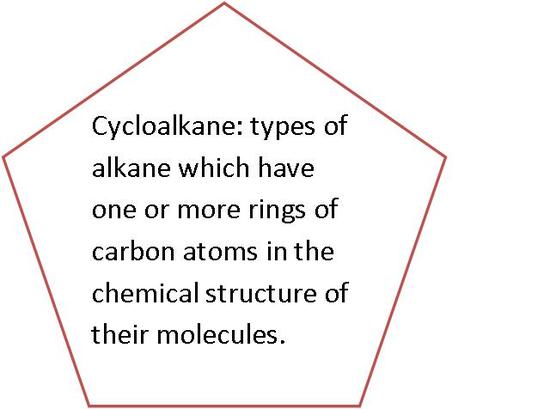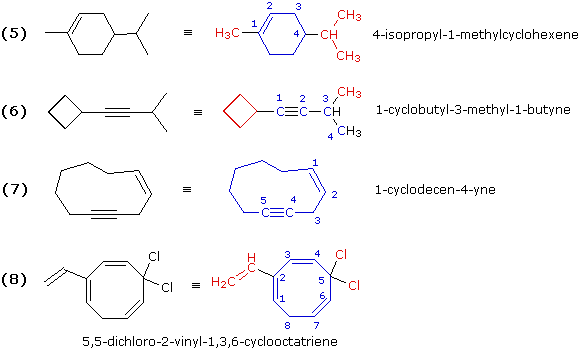


 علم الكيمياء
علم الكيمياء 
 الكيمياء التحليلية
الكيمياء التحليلية 
 الكيمياء الحياتية
الكيمياء الحياتية 
 الكيمياء العضوية
الكيمياء العضوية 
 الكيمياء الفيزيائية
الكيمياء الفيزيائية
 الكيمياء اللاعضوية
الكيمياء اللاعضوية 
 مواضيع اخرى في الكيمياء
مواضيع اخرى في الكيمياء
 الكيمياء الصناعية
الكيمياء الصناعية |
Read More
Date: 26-1-2020
Date: 26-1-2020
Date: 18-1-2020
|
Endocyclic double bonds have both carbons in the ring and exocyclic double bonds have only one carbon as part of the ring.

Cyclopentene is an example of an endocyclic double bond.

Methylenecylopentane is an example of an exocyclic double bond.

Name the following compounds...
1-methylcyclobutene. The methyl group places the double bond. It is correct to also name this compound as 1-methylcyclobut-1-ene.

1-ethenylcyclohexene, the methyl group places the double bond. It is correct to also name this compound as 1-ethenylcyclohex-1-ene. A common name would be 1-vinylcyclohexene.
Try to draw structures for the following compounds...

Both these compounds have double bonds, making them alkenes. In example (1) the longest chain consists of six carbons, so the root name of this compound will be hexene. Three methyl substituents (colored red) are present. Numbering the six-carbon chain begins at the end nearest the double bond (the left end), so the methyl groups are located on carbons 2 & 5. The IUPAC name is therefore: 2,5,5-trimethyl-2-hexene.
In example (2) the longest chain incorporating both carbon atoms of the double bond has a length of five. There is a seven-carbon chain, but it contains only one of the double bond carbon atoms. Consequently, the root name of this compound will be pentene. There is a propyl substituent on the inside double bond carbon atom (#2), so the IUPAC name is: 2-propyl-1-pentene.

The double bond in example (3) is located in the center of a six-carbon chain. The double bond would therefore have a locator number of 3 regardless of the end chosen to begin numbering. The right hand end is selected because it gives the lowest first-substituent number (2 for the methyl as compared with 3 for the ethyl if numbering were started from the left). The IUPAC name is assigned as shown.
Example (4) is a diene (two double bonds). Both double bonds must be contained in the longest chain, which is therefore five- rather than six-carbons in length. The second and fourth carbons of this 1,4-pentadiene are both substituted, so the numbering begins at the end nearest the alphabetically first-cited substituent (the ethyl group).

These examples include rings of carbon atoms as well as some carbon-carbon triple bonds. Example (6) is best named as an alkyne bearing a cyclobutyl substituent. Example (7) is simply a ten-membered ring containing both a double and a triple bond. The double bond is cited first in the IUPAC name, so numbering begins with those two carbons in the direction that gives the triple bond carbons the lowest locator numbers. Because of the linear geometry of a triple bond, a-ten membered ring is the smallest ring in which this functional group is easily accommodated. Example (8) is a cyclooctatriene (three double bonds in an eight-membered ring). The numbering must begin with one of the end carbons of the conjugated diene moiety (adjacent double bonds), because in this way the double bond carbon atoms are assigned the smallest possible locator numbers (1, 2, 3, 4, 6 & 7). Of the two ways in which this can be done, we choose the one that gives the vinyl substituent the lower number.



|
|
|
|
لخفض ضغط الدم.. دراسة تحدد "تمارين مهمة"
|
|
|
|
|
|
|
طال انتظارها.. ميزة جديدة من "واتساب" تعزز الخصوصية
|
|
|
|
|
|
|
مشاتل الكفيل تزيّن مجمّع أبي الفضل العبّاس (عليه السلام) بالورد استعدادًا لحفل التخرج المركزي
|
|
|